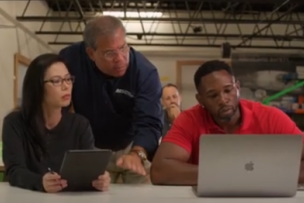Flooring has a lot more versatility. Since it’s assembled with interlocking tiles, it can cover larger areas, and can accommodate just about any geometric shape to fit even the most unique job process. It can be utilized in environments that are wet or oily, as it does not have the sponge material underneath.
It is available with or without holes, to facilitate drainage of fluids and debris. Flooring also offers fatigue-fighting properties as it elevates the standing worker above the unforgiving field of concrete.
Concrete can be slippery. Installing flooring can additionally help to reduce injury in the event of a slip. It protects floors and covers imperfections, and a single tile can be replaced instead of a whole floor, saving thousands in costly repairs. Walkways are defined easily, and there is even an option for color safety boards to give visual cues to change in the walking plane. The availability of color can contribute to safety, aesthetics and LEAN manufacturing initiatives like 5S (system for organizing spaces so work is performed efficiently, effectively, and safely).
The choice to utilize flooring or matting boils down to the application challenge to be solved. The greatest point is both are valuable in improving safety and productivity so your employees perform at their best and are in just as great of shape at the end as they are at the start of the day.





Talk to Us!
Dear Sir Or Madam,
I would like to get an offer for a 10 meters length Ergonomic Flooring,
Also for yellow edge (like in picture) - 20 meters length.
Thank you,
Yanir
4Leave a reply
Your email address will not be published. Required fields are marked *